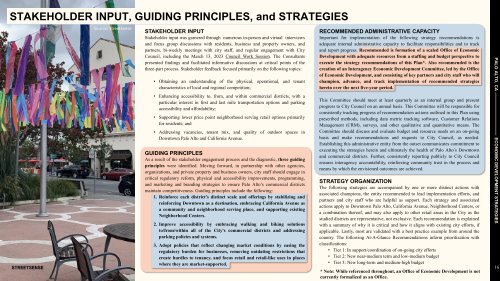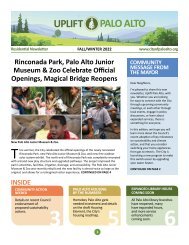Palo Alto Economic Development Strategies
You also want an ePaper? Increase the reach of your titles
YUMPU automatically turns print PDFs into web optimized ePapers that Google loves.
STAKEHOLDER INPUT, GUIDING PRINCIPLES, and STRATEGIES<br />
Source: Streetsense<br />
STAKEHOLDER INPUT<br />
Stakeholder input was garnered through numerous in-person and virtual interviews<br />
and focus group discussions with residents, business and property owners, and<br />
partners, bi-weekly meetings with city staff, and regular engagement with City<br />
Council, including the March 13, 2023 Council Work Session. The Consultants<br />
presented findings and facilitated informative discussions at critical points of the<br />
three-part process. Stakeholder feedback focused primarily on the following topics:<br />
• Obtaining an understanding of the physical, operational, and tenant<br />
characteristics of local and regional competition;<br />
• Enhancing accessibility to, from, and within commercial districts, with a<br />
particular interest in first and last mile transportation options and parking<br />
accessibility and affordability;<br />
• Supporting lower price point neighborhood serving retail options primarily<br />
for residents; and<br />
• Addressing vacancies, tenant mix, and quality of outdoor spaces in<br />
Downtown <strong>Palo</strong> <strong>Alto</strong> and California Avenue.<br />
GUIDING PRINCIPLES<br />
As a result of the stakeholder engagement process and the diagnostic, three guiding<br />
principles were identified. Moving forward, in partnership with other agencies,<br />
organizations, and private property and business owners, city staff should engage in<br />
critical regulatory reform, physical and accessibility improvements, programming,<br />
and marketing and branding strategies to ensure <strong>Palo</strong> <strong>Alto</strong>’s commercial districts<br />
maintain competitiveness. Guiding principles include the following:<br />
1. Reinforce each district's distinct scale and offerings by stabilizing and<br />
reinforcing Downtown as a destination, embracing California Avenue as<br />
a community and neighborhood serving place, and supporting existing<br />
Neighborhood Centers.<br />
2. Improve accessibility by embracing walking and biking solutions<br />
to/from/within all of the City's commercial districts and addressing<br />
parking policies and systems.<br />
3. Adopt policies that reflect changing market conditions by easing the<br />
regulatory burden for businesses, removing outdating restrictions that<br />
create hurdles to tenancy, and focus retail and retail-like uses in places<br />
where they are market-supported.<br />
RECOMMENDED ADMINISTRATIVE CAPACITY<br />
Important for implementation of the following strategy recommendations is<br />
adequate internal administrative capacity to facilitate responsibilities and to track<br />
and report progress. Recommended is formation of a scaled Office of <strong>Economic</strong><br />
<strong>Development</strong> with adequate resources from a staffing and budget perspective to<br />
execute the strategy recommendations of this Plan*. Also recommended is the<br />
creation of an Interagency <strong>Economic</strong> <strong>Development</strong> Committee, led by the Office<br />
of <strong>Economic</strong> <strong>Development</strong>, and consisting of key partners and city staff who will<br />
champion, advance, and track implementation of recommended strategies<br />
herein over the next five-year period.<br />
This Committee should meet at least quarterly as an internal group and present<br />
progress to City Council on an annual basis. This Committee will be responsible for<br />
consistently tracking progress of recommendation actions outlined in this Plan using<br />
prescribed methods, including data metric tracking software, Customer Relations<br />
Management (CRM), surveys, and other qualitative and quantitative means. The<br />
Committee should discuss and evaluate budget and resource needs on an on-going<br />
basis and make recommendations and requests to City Council, as needed.<br />
Establishing this administrative entity from the outset communicates commitment to<br />
executing the strategies herein and ultimately the health of <strong>Palo</strong> <strong>Alto</strong>’s Downtown<br />
and commercial districts. Further, consistently reporting publicly to City Council<br />
ensures interagency accountability, reinforcing community trust in the process and<br />
means by which the envisioned outcomes are achieved.<br />
STRATEGY ORGANIZATION<br />
The following strategies are accompanied by one or more distinct actions with<br />
associated champions, the entity recommended to lead implementation efforts, and<br />
partners and city staff who are helpful as support. Each strategy and associated<br />
actions apply to Downtown <strong>Palo</strong> <strong>Alto</strong>, California Avenue, Neighborhood Centers, or<br />
a combination thereof, and may also apply to other retail areas in the City as the<br />
studied districts are representative, not exclusive. Each recommendation is explained<br />
with a summary of why it is critical and how it aligns with existing city efforts, if<br />
applicable. Lastly, most are validated with a best practice example from around the<br />
country. The following At-A-Glance Recommendations inform prioritization with<br />
classifications:<br />
• Tier 1: In support/coordination of on-going city efforts<br />
• Tier 2: New near-medium term and low-medium budget<br />
• Tier 3: New long-term and medium-high budget<br />
* Note: While referenced throughout, an Office of <strong>Economic</strong> <strong>Development</strong> is not<br />
currently formalized as an Office.<br />
PALO ALTO, CA —————————— ECONOMIC DEVELOPMENT STRATEGIES<br />
16
















